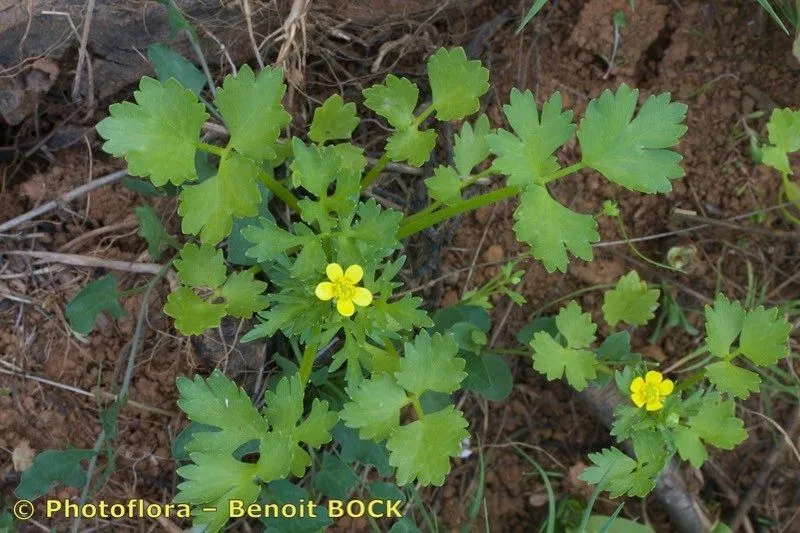
Author: Desf.
Bibliography: Fl. Atlant. 1: 437 (1798)
Year: 1798
Status: accepted
Rank: species
Genus: Ranunculus
Vegetable: False
Observations: Macaronesia, W. & C. Medit.
The Threelobe Buttercup, scientifically known as Ranunculus trilobus, is a member of the Ranunculaceae family, notable for its vibrant appearance and unique three-lobed leaves. First described in 1798 in “Flora Atlantica” by the esteemed botanist Desfontaines, Ranunculus trilobus has since been recognized for its distinct attributes and adaptability.
This alluring plant has been observed in various regions, flourishing predominantly in Macaronesia and extending through the Western and Central Mediterranean areas. Its adaptability to different climatic conditions in these regions underscores its resilience and versatile growth patterns.
Thriving in a range of environments from coastal areas to inland locales, the Threelobe Buttercup often captures interest due to its bright, butter-yellow flowers. These petals contrast beautifully with the deeply lobed leaves, giving the plant its common name and providing a vivid splash of color to the landscapes it inhabits.
Typically found in grassy meadows, fallow lands, and open woodlands, Ranunculus trilobus tends to favor moist soils but is surprisingly adaptable to various soil conditions. Its blooming period, which spans from late winter to early spring, offers an early burst of color and is a welcome sight after the colder seasons.
The Threelobe Buttercup, while appreciated for its aesthetic value, also plays a significant role in the ecosystem. It provides an early nectar source for pollinators such as bees and butterflies, supporting the biodiversity of the areas it populates.
In summary, Ranunculus trilobus, or the Threelobe Buttercup, is a striking plant of notable botanical interest. Its presence from Macaronesia to the Mediterranean serves as a testament to its adaptability and the enduring appeal of this vivid buttercup species.
Deu: dreilappiger hahnenfuß
Spa: ranunculo perejil
Eng: threelobe buttercup
En: Threelobe buttercup, Three-Lobe Buttercup, Hairy Buttercup
Fi: Nyppyleinikki
Fr: Renoncule à feuilles à trois lobes, Renoncule à trois lobes, Renoncule trilobée
De: Dreilappiger Hahnenfuß
It: Ranuncolo trilobo
Es: Ranunculo perejil
© copyright of the Board of Trustees of the Royal Botanic Gardens, Kew.
© copyright of the Board of Trustees of the Royal Botanic Gardens, Kew.
© copyright of the Board of Trustees of the Royal Botanic Gardens, Kew.
Taken Jan 6, 2021 by Gaifém Luís (cc-by-sa)
Taken May 14, 2022 by Carlos F. Ingala (cc-by-sa)
Taken May 14, 2018 by Tela Botanica − José Luis ROMERO REGO (cc-by-sa)
Taken May 14, 2018 by Tela Botanica − José Luis ROMERO REGO (cc-by-sa)
Taken May 14, 2018 by Tela Botanica − José Luis ROMERO REGO (cc-by-sa)
Taken May 14, 2022 by Carlos F. Ingala (cc-by-sa)
Taken Apr 15, 2016 by Photoflora – Jean-Luc TASSET (©)
Taken Apr 15, 2007 by Photoflora – Jean-Luc TASSET (©)
Taken May 14, 2018 by Tela Botanica − José Luis ROMERO REGO (cc-by-sa)
Taken May 14, 2018 by Tela Botanica − José Luis ROMERO REGO (cc-by-sa)
Taken Apr 2, 2021 by Macías gema (cc-by-sa)
Taken May 14, 2022 by Carlos F. Ingala (cc-by-sa)
Taken Apr 15, 2016 by Photoflora – Jean-Luc TASSET (©)
Taken Apr 15, 2007 by Photoflora – Jean-Luc TASSET (©)
Taken May 14, 2018 by Tela Botanica − José Luis ROMERO REGO (cc-by-sa)
Taken Apr 15, 2017 by Photoflora – Benoit BOCK (©)
Taken Apr 15, 2017 by Photoflora – Benoit BOCK (©)
Taken Apr 15, 2017 by Photoflora – Benoit BOCK (©)
Taken Apr 15, 2017 by Photoflora – Benoit BOCK (©)
Taken Apr 15, 2017 by Photoflora – Benoit BOCK (©)
Taken Apr 15, 2007 by Photoflora – Jean-Luc TASSET (©)
Taken Apr 15, 2007 by Photoflora – Jean-Luc TASSET (©)
Taken Apr 15, 2007 by Photoflora – Jean-Luc TASSET (©)
Taken Apr 15, 2007 by Photoflora – Jean-Luc TASSET (©)
Taken Apr 15, 2017 by Photoflora – Benoit BOCK (©)
Growth habit>: Forb/herb
Ph maximum: 5.5
Ph minimum: 5.0
Light: 9
Atmospheric humidity: 8
Bloom months: [‘may’, ‘jun’, ‘jul’, ‘aug’]
Soil nutriments: 3
Family: Myrtaceae Author: (F.Muell.) K.D.Hill & L.A.S.Johnson Bibliography: Telopea 6: 402 (1995) Year: 1995 Status:…
Family: Rubiaceae Author: Pierre ex A.Froehner Bibliography: Notizbl. Bot. Gart. Berlin-Dahlem 1: 237 (1897) Year:…
Family: Sapindaceae Author: Koidz. Bibliography: J. Coll. Sci. Imp. Univ. Tokyo 32(1): 38 (1911) Year:…
Family: Asteraceae Author: A.Gray Bibliography: Pacif. Railr. Rep.: 107 (1857) Year: 1857 Status: accepted Rank:…
Family: Fabaceae Author: Medik. Bibliography: Vorles. Churpfälz. Phys.-Ökon. Ges. 2: 398 (1787) Year: 1787 Status:…
Family: Aspleniaceae Author: (Cav.) Alston Bibliography: Bull. Misc. Inform. Kew 1932: 309 (1932) Year: 1932…